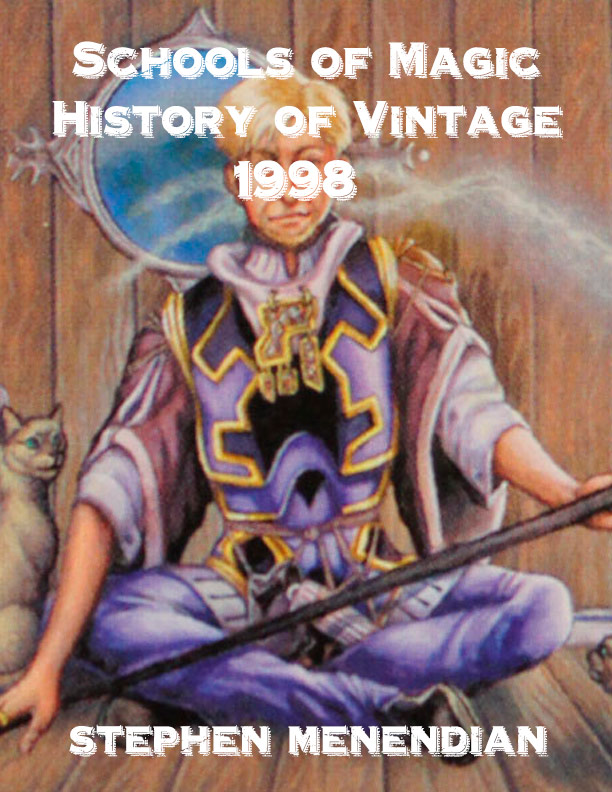Description
Continuing in the Schools of Magic: History of Vintage series, author Stephen Menendian retraces the history of 1998, an unforgettable year in the history of Type I. Follow the important changes to the Restricted List, the rise of recursion strategies and new combo decks, and the lasting impact of Urza’s Saga on the format. Read about the birth Oath and Workshop Aggro decks in the format, and about the continuing evolution of The Deck, Necropotence, Prosperity, and Zoo strategies.
[Begin Free Excerpt From Schools of Magic: History of Vintage – 1998]
Combination strategies were an incipient part of the format. The first combo, the Time Vault combo, was immediately restricted, and banned quickly thereafter. The infamous Channel-Fireball combo was featured in the finals of the first Magic World Championship, and was a part of the format that would become “Type I” before it was even given that designation. Channel’s banning in late 1995 also eliminated that combo from the format. Prosperity Vice brought a new kind of combo deck to the format, and was quickly followed by the Doomsday combo. Stronghold brought into the realm of possibility an entire new combo engine around a card that was thought innocuous if not useless: Dream Halls.
Just as the tournament season was gearing up – as players were preparing for Nationals, Zvi Mowshowitz, then a relative unknown, published a brilliant deck in Standard that sent shockwaves throughout the field.
TurboZvi, by Zvi Mowshowitz
| Business (35) 4 Dream Halls 4 Intuition 4 Meditate 4 Sift 4 Ancestral Memories 4 Mana Severance 4 Memory Lapse 1 Counterspell 1 Impulse 1 Lobotomy 1 Inspiration 3 Gaea’s Blessing Mana Sources (25) 4 Lotus Petal 4 Crystal Vein 4 Svyelunite Temple 4 Ancient Tomb 9 Island | Sideboard (15) 4 Adarkar Wastes 4 Abeyance 4 Hydroblast 1 Dismiss 1 Inspiration 1 Lobotomy |
TurboZvi uses Dream Halls as a terminal spell: it is the final spell you have to cast with mana. From there, you can set up an infinite recursion loop. The critical card is Gaea’s Blessing. Recall that recursion decks were a major feature of the early years of the game, especially when focused around Timetwister. It was possible and even desirable to set up recursive loop combo decks that could go on forever or until they won the game. With TurboZvi, that’s exactly what they did.
Once Dream Halls resolves, you play Meditates or other draw spells until you hit Gaea’s Blessing to shuffle them back into your library. Eventually, you draw your entire deck, cast your win condition, such as Lobotomy or Inspiration, and then recur it with Blessing. Gaea’s Blessing, which was printed in Weatherlight, quickly entered the spotlight as a unique and important tactic across formats. It became clear that Blessing was one of the most powerful recursion engines printed since Timetwister.
The advent of TurboZvi generated controversy on the Internet, but all appreciated its genius. Its obvious weakness was permission, since Dream Halls would make permission spells all Force of Wills. Nonetheless, the power of the concept was undeniable.
[End Free Excerpt]

